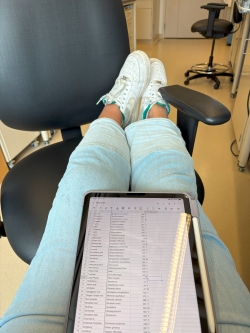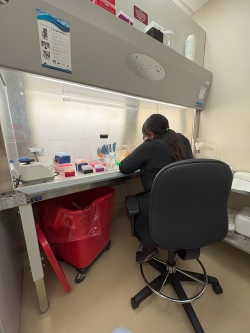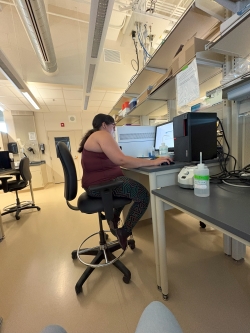With the guidance of Dr. Keller and Dr. Wlodarchak, my project officially began. We started by compiling a list of 20 botanicals that might contain bioactive compounds with healing properties. That list quickly expanded after just one meeting, and it doubled to 45 botanicals and 5 naturally occurring chemical compounds.
Dr. Keller’s extensive background in botanical science turned out to be an incredible resource. She curated a massive collection of botanicals, housed in a walk-in fridge that honestly smelled more like a spice shop than a lab storage space. Shelves from floor to ceiling were filled with boxes of teas, leaves, and roots.This fridge was the unsung hero for me given I can barely keep a fake plant looking alive, let alone grow real ones for research. Even better, the collection didn’t just include dried materials; it also had pre-made extracts, which I need next week to prepare the solutions for my screenings.
Locating these extracts meant braving the -80℃ freezer. Dr.Keller and I had to brush away layers of frost to uncover vials labeled with reference numbers tied to the master catalogue. With my plants collected, I was able to set them aside for the following week when I prepare my solutions to create my first plate.
 Sitting at my desk in my favorite chair working on my plant list
Sitting at my desk in my favorite chair working on my plant list The remainder of the week was spent working alongside two of my favorite research assistants, Garett and Melissa. With their guidance, I was able to observe the full process of a technique called flow cytometry. This went from growing the cells to staining them then, finally, to running the analysis.
 Time in the sterile room with Melissa learning how to remove cells
Time in the sterile room with Melissa learning how to remove cellsWatching the workflow unfold in real time gave me a clear understanding of how closely lab research mirrors real-world problem-solving. When setbacks occur, there's no option to simply postpone. The experiment must move forward.
One example involved a compound called adiponectin. We needed it to be delivered; however, not only was it delayed, but we later learned it was on backorder for another two to three weeks. Since the cells were already in progress and couldn't be paused or restarted on a whim, we had to adapt quickly. The solution was to pivot and test another compound from our study, just in a different context than originally planned. While it wasn’t the ideal scenario, the new direction still holds scientific value, and, more importantly, the experiment was able to continue without delay.
 Melissa running Flow Cytometry
Melissa running Flow CytometryThe work week wrapped up with a Friday lunch out on the town (well, on Colfax). It was the perfect way to close out a productive week. Beyond the great food, the lunch offered a valuable opportunity to network. I had the chance to meet and speak with one of Dr. Keller’s former lab assistants. Our conversation provided me with insight into her experience in the lab and how it has helped shape her path moving forward. Hearing about her journey provided both perspective and knowledge for what may come next.